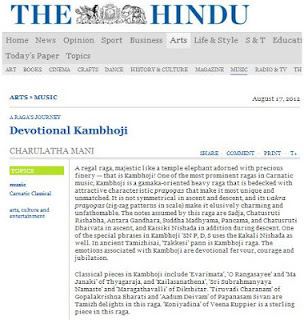 | ||
Kambhoji or Kambodhi is a sublime classical raga or musical mode (anciently known as Kambhoja or Kamboja), which is very popular in Indian musical landscape It is known as Thakkesi pann in ancient Tamil music(3BCE) which is the oldest reference to this musical mode.
Contents
2012 concert by ranjani gayathri
Medieval era
There are numerous references to Raga or Ragini called Kambhoji in ancient Indian musical traditions. Narada's Sangita Makarand (7th to 8th century AD) broadly classifies Ragas into eight subsets and includes three raginis in each subset. In this scheme of classification, Narda accepts raga Kambhoji as a mode of Shri raga, the first subset of his scheme of classification. Ramaditya, the author of Swara-Mela Kalanidhi (1550 AD) has accepted 20 melas and has accommodated 64 Jana-ragas among the melas. In this scheme of classification, the twentieth mela is Kambhoji under which come the Jana-ragas like Kambhoji. Ragamala of Pundrikavitthala classifies ragas into six divisions with each group having several raginis and ragas imagined to be their spouses and sons. Thus the ragini Kambhoji is assumed to be one among the several spouses of raga Nat-Narayana. Chatravarishach.chhat-Raga Nirupanam authored by Narada (1525-50 AD) lists ten main ragas and accepts the Kambhoji as the spouse of seventh raga called Raga Nata-Narayana. Chaturdandi-Prakashhika authored by Vyankatmakhi (also known as Vyankateshwara Dikshit, ~1660 AD) assumes 19 melas and lists the Kamboji, Kedar-gaula and Narayan-gaula as the Jana ragas under mela Kambhoji. The Anupa-Sangit-Ratanakar by Sangit Acharya Bhava-Bhata lists 20 ragas as being fundamental ragas. The third raga of his scheme, called Kedar Raga, includes more than a dozen of raginis----the seventh being the well known Kambhoji. Raja Tulaji, the ruler of Tanjore (1763-87 AD) has written a well known book on musicology known as Sangit-Saramritoddhar. Raja Tulaji assumes 21 Janakmelas and includes Kambhoji and Yadukul-Kambhoji as the Jana ragas under the eighth Janaka-mela of his scheme of classification.
Classification according to gender
Sangit-Makrand also classifies the ragas according to their gender i.e. Male Ragas, Female Ragas (i.e., Raginis) and Neuter Ragas. According to Narada, the Male Ragas depict emotions of Raudra (anger), Veera (heroic) and Bhayanaka (fearful); the Female Ragas represent sentiments of Shringara (romantic and erotic), Hasya (humorous) and Karuna (pathetic); while the Neuter Ragas represent emotions of Vibhatsa (disgustful), Adbhuta (amazement) and Shanta (peaceful).
Each raga is principally dominated by one of these nine rasas or sentiments, although the performer can also bring out other emotions in a less prominent way. The more closely the notes of a raga conform to the expression of one single idea or emotion, the more overwhelming the effect of the raga.
Since the Raga Kambhoji has been classified as Female Raga (i.e., Ragini), this Raga is particularly suitable in conveying the sentiments of Shringara (romantic and erotic), Hasya (humorous) and Karuna (pathos).
